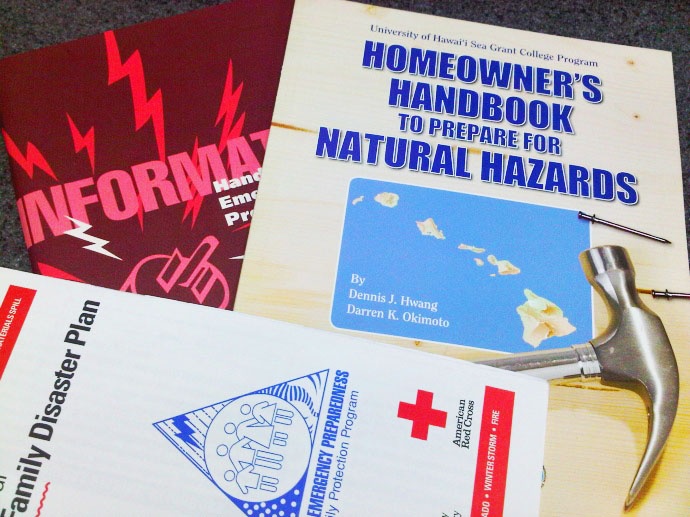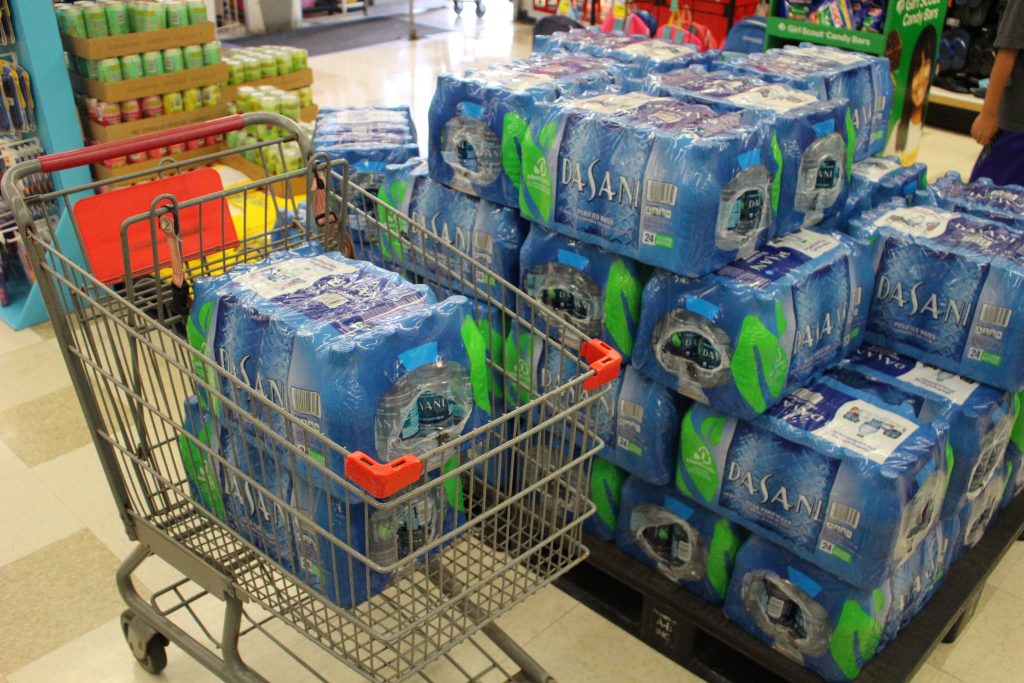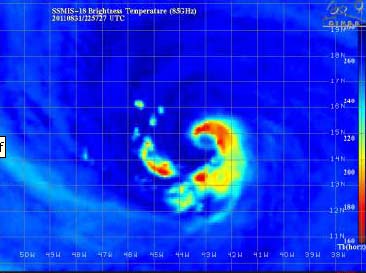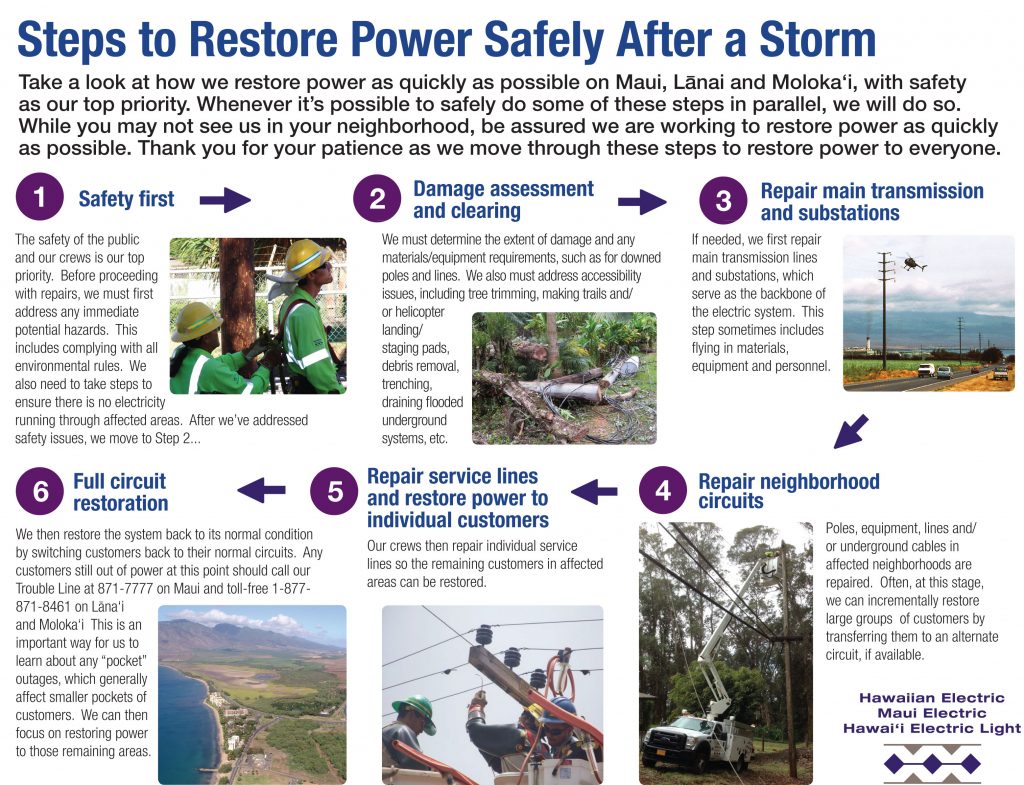Storm Preparedness Tips for Madeline and Lester

Emergency preparedness pamphlets are available from the Maui County Civil Defense Agency. Photo by Wendy Osher.
What to Do When a hurricane or tropical storm threatens:
- Secure loose outdoor objects that might be blown away by high winds, and become flying debris.
- Boats should be moored securely, or moved to a designated safe area well before the storm arrives.
- Windows should be boarded up. Larger windows may be broken by wind pressure, while smaller windows are mainly damaged by wind driven debris.
- If evacuation is required, be sure to take your disaster supply kit when leaving for a designated shelter. Keep in mind that evacuation routes may become flooded or cut off, even before the full force of the tropical cyclone arrives.

Storm prep, file photo 7.22.16
What to do during the Watch:
A hurricane or tropical storm watch is issued when conditions are expected in the specified area of the watch within 48 hours. When a hurricane or tropical storm watch is issued:
- Fuel and service family vehicles
- Prepare to cover all windows and door openings with boards, shutters or other shielding materials
- Store and secure outdoor lawn furniture and other loose, lightweight objects, such as garbage cans and garden tools
- Check and replenish disaster supply kits
- Have an extra supply of cash on hand
When is a Warning Issued:
A tropical storm or hurricane warning is issued when conditions are expected in the specified area of the warning, usually within 36 hours.
When a hurricane or tropical storm warning is issued, follow instructions issued by local emergency management officials. Leave immediately if ordered to do so. Complete preparation activities, such as boarding up windows and storing loose objects.
Evacuate areas that might be affected by storm surge flooding. When evacuating, leave early. Utilize your family’s disaster preparedness plan. Notify neighbors and a family member outside the warned area of your evacuation plans.
During a hurricane or tropical storm event, if you live inland away from the beach, and away from low-lying areas, and your home is well constructed, stay at home.
Once a hurricane or tropical storm arrives in your area, remain indoors in an interior room. Blowing debris can be deadly. Travel should be avoided. Plan now and have a disaster supply kit on hand.
What to Expect from Winds and Rains:
In Hawaiʻi, mountainous terrain accelerates hurricane and tropical storm winds causing extremely high winds that can destroy buildings, structures, trees, vegetation and crops.
Heavy and prolonged rains can accompany all types of tropical cyclones including hurricanes, tropical storms, and tropical depressions. Even the weakest tropical depressions can bring torrential rains and flash flooding to the Hawaiian Islands.
When forming a disaster preparedness plan, consider each factor and how it could affect your family and property.
If you Evacuate:
If you evacuate during an emergency, turn off the utilities in your home. Turn off all water faucets, make sure electricity is turned off at the main switch, and turn off gas at the main valve.
Emergency preparedness is an individual responsibility. Be prepared.

Hurricane Iniki microwave precipitation imagery. File image courtesy Central Pacific Hurricane Center.
Did you know?
Hurricanes not only pack high winds, but can also cause torrential rains that lead to flash flooding and abnormally high waves and storm surge. Known as “The Triple Threat”, each of these alone can pose a serious threat to life and property. Taken together they are capable of inflicting a large loss of life and widespread destruction.
In 1992, Hurricane Iniki’s high waves and storm surge devastated the south shore of Kauai to elevations over 20 feet above sea level. As the hurricane nears the coastline, rapidly rising water levels from wind-driven waves and storm surge will inundate coastal areas, erode beaches, and pound and undermine waterfront structures and roadways.
Develop a family disaster preparedness plan now.
Determine evacuation routes from your home and places to meet. Determine the location of official shelters. Have an out of state contact, so all your family members have a single point of contact.
Make a plan for what to do with your pets if you need to evacuate. Check your insurance coverage; flood damage is not usually covered by homeowners insurance.
For information when a hurricane or tropical storm threatens your area refer to the following resources.
The National Weather Service provides valuable information via the internet, NOAA Weather Radio and Local Telephone Recordings.
State and County Civil Defense, Federal Emergency Management Agency and the Red Cross. Local television and radio media provide a constant source of updated information.
The Red Cross encourages everyone to be prepared before disasters strike: Get a disaster kit, make a plan and be informed.
Every family should have their own disaster kit. As other emergency response organizations have reported, families are asked to bring their own disaster supplies kit to a shelter, if asked to evacuate. Have 7 days’ worth of supplies at home to shelter in place or in a compact portable container to take to a shelter. Full details about what the kit should contain are available at www.redcross.org/hawaii (see Programs and Services/Disaster Preparedness).
Water – 1 gallon per person per day
Food – non-perishable
Flashlight
Radio -NOAA Weather Radio
Extra batteries
First aid kit
Medications & Medical items
Manual Can opener
Multi-purpose tool
Personal hygiene items
Copies of Documents (prescriptions, proof of address, deed/lease to home, insurance policies and proof of identity)
Cell phone with chargers
Family Contact Information
Cash
Bedding
Change of clothes
Towels
Dishes
You may also need:
Baby supplies – bottles, baby food & diapers
Games and activities
Comfort items
Pet supplies – collar, leash, ID, food, water, carrier, bowl & medications
What to do with your Pets?
With the onset of a Madeline, the Humane Society offers a few tips to help keep animals safe during and after the storm:
- Bring pets inside.
- Animals have instincts about severe weather changes and may isolate themselves if they are afraid. Bringing them inside early can stop them from running away. Never leave a pet tied up during a storm.
- Make sure your pet is wearing a collar and ID tag.
- Separate dogs and cats. Even if your dogs and cats normally get along, the anxiety of an emergency situation can cause pets to act irrationally.
- If you find a stray pet during the storm, please provide it shelter and then drop it off when weather conditions clear at the Humane Society.
- Pet owners are encouraged to be safe and well prepared. If you are advised to evacuate or do not trust the stability of your home, please consider your pet’s safety.
Come prepared with these items: Crate, Leash, Food, Water, Bowls, Towel, Litter and litter box, and Identification
Medication (if applicable).
Shelters are for safety only and will not have the comforts of home. Pet owners need to stay with their pet and provide the necessary care.

Maui Electric storm prep tips
Maui Electric Safety Tips:
As Maui Electric employees prepare for potential impacts from approaching Hurricanes Madeline and Lester, Maui Electric wants to remind customers that electricity can be dangerous and electrical safety should never be taken for granted, especially during an emergency situation.
“Keeping our employees and our community safe is our top priority as we prepare for and respond to storms,” said Maui Electric President Sharon Suzuki. “We encourage everyone to complete their emergency preparations. If the electrical system is impacted on Maui, Moloka‘i or Lana‘i, our Maui Electric crews are ready to respond. Our incident management team is assembling and response crews are currently gearing up and preparing equipment and supplies.”
Maui Electric reminds everyone of these important electrical safety measures before, during, and after a disaster or power outage:
• Before a storm hits or if there is a power outage, unplug all unnecessary electric equipment and appliances until the storm has passed or until power is restored.
• Stay away from downed power lines. Assume they are energized and dangerous. If you see someone injured after touching a downed power line, call 9-1-1 for help.
• Should you need to evacuate, take emergency supplies and remember to shut off electricity at the main breaker or switch.
• Make plans in advance to go to a safe location where electricity will be available if someone in your home depends on an electrically powered life support system and you don’t have a backup generator. Some shelters are designed for people with health needs—just remember to take your own medical equipment and medications.
• When using a portable generator, carefully read and follow instructions in the manufacturer’s manual. Do not plug the generator into your household electrical outlets.
• If you have a rooftop photovoltaic system, consult with your licensed solar contractor regarding normal and emergency operation procedures for your solar system. As a safety precaution, most photovoltaic systems are designed to safely shut down during outages. PV systems typically have monitoring systems which allow owners to check on the status of their system.
Maui Electric’s free “Information Handbook for Emergency Preparedness” – available in five languages – includes these tips and more. It can be downloaded at www.mauielectric.com/prepare. The handbook includes key numbers to have on hand, checklists for emergency supplies, power outage preparedness and recovery information, and household and food safety tips.
To report a power outage, call the Maui Electric Trouble Line at (808) 871-7777 or 911 if it’s an emergency. The public can also sign up for outage notifications and restoration updates at www.mauielectric.com or follow Maui Electric on Twitter @mauielectric. Due to uncontrolled forces of nature, such as hurricanes, power outages may occur and with safety of our crews and the public as our top priority – as soon as conditions are safe to do so – crews are sent out to assess and begin repairs to restore power as quickly as possible. See these restoration steps at https://www.mauielectric.com/safety-and-outages/storm-center.










